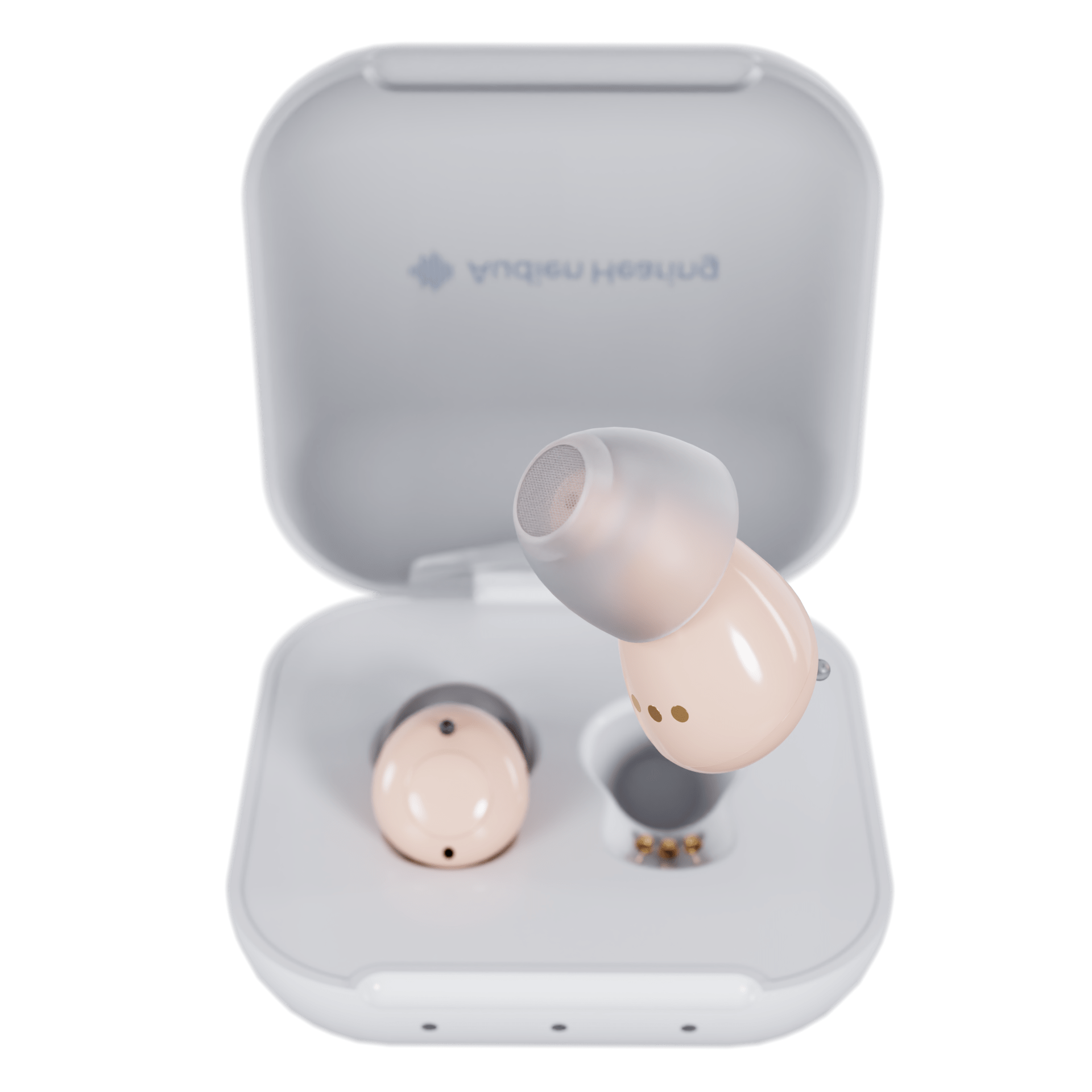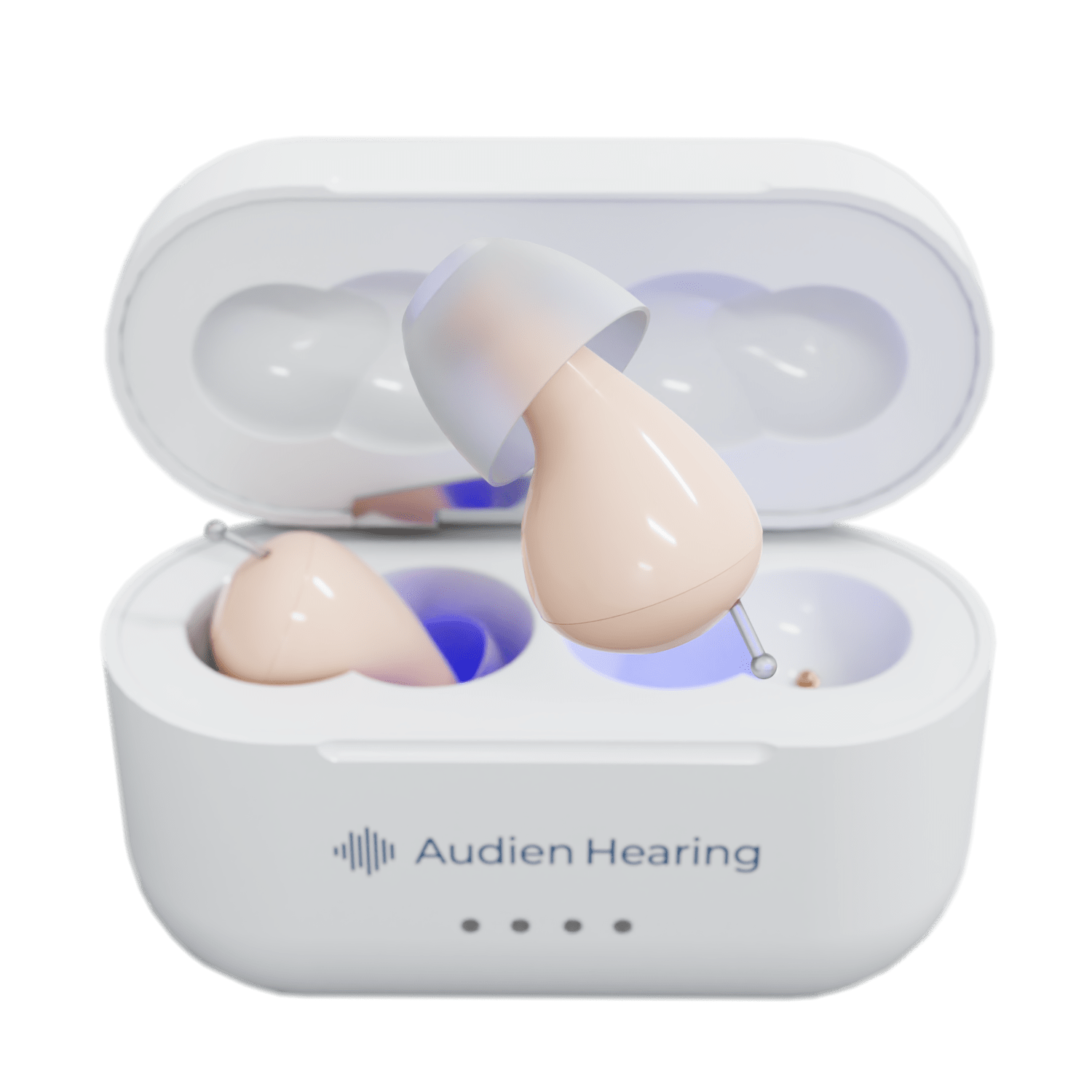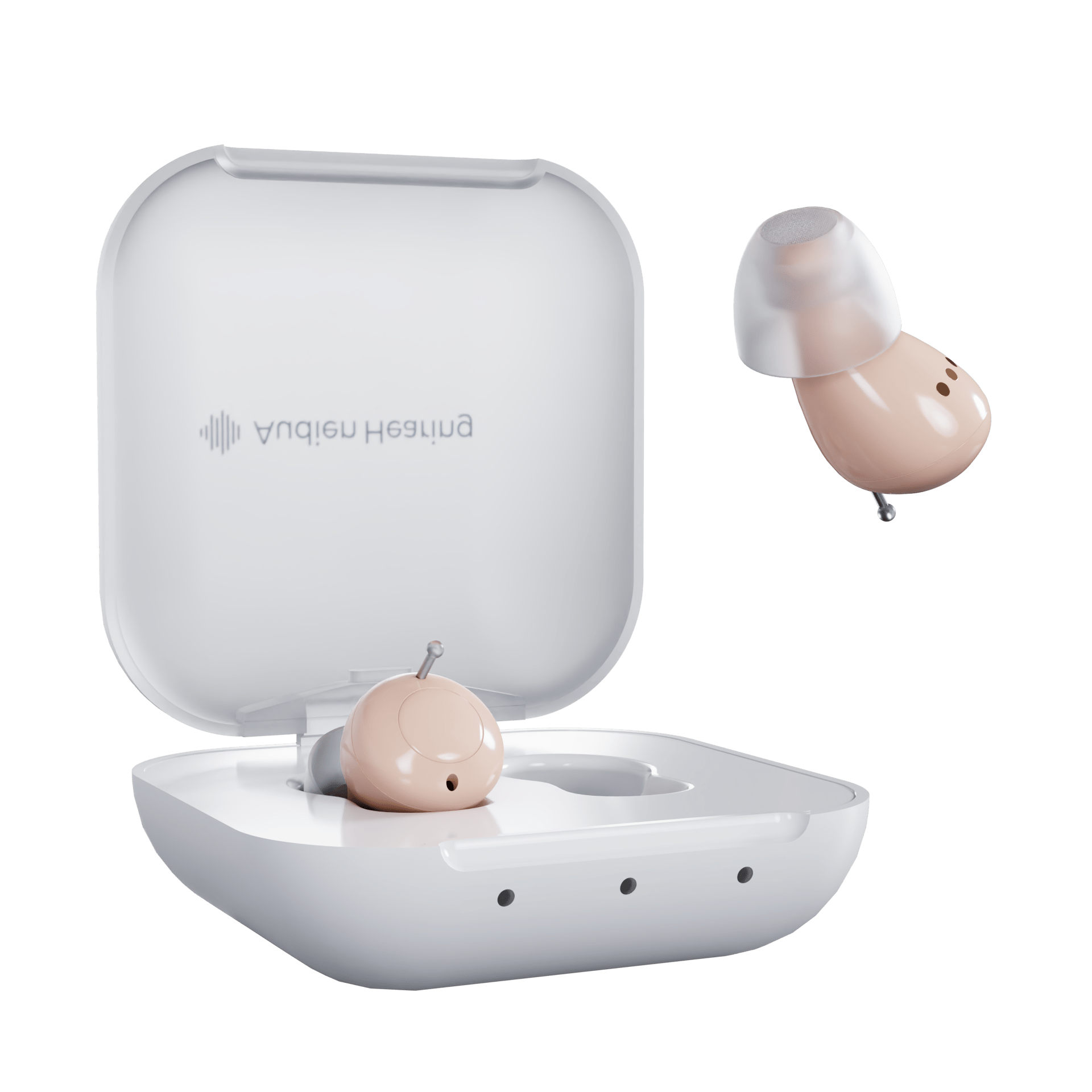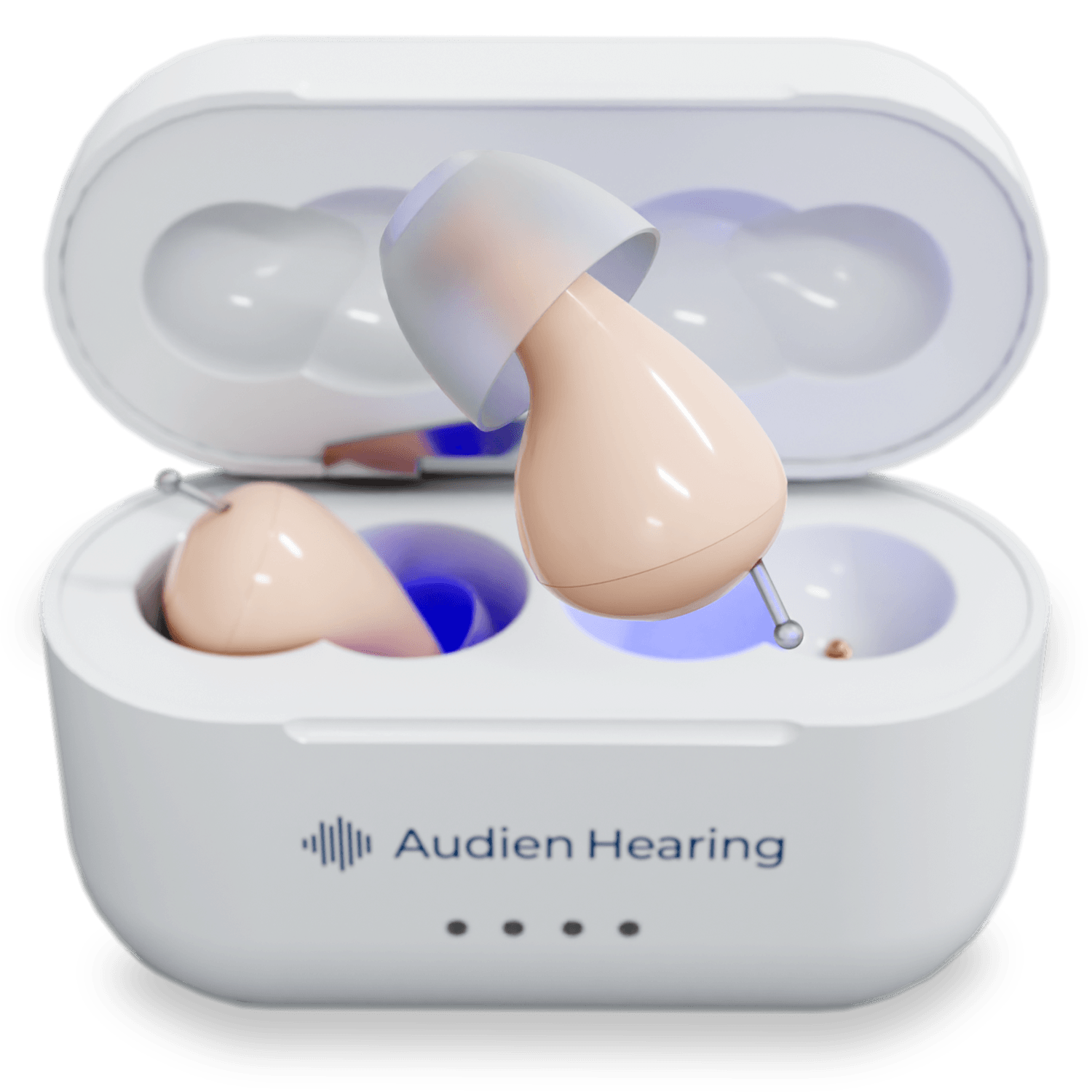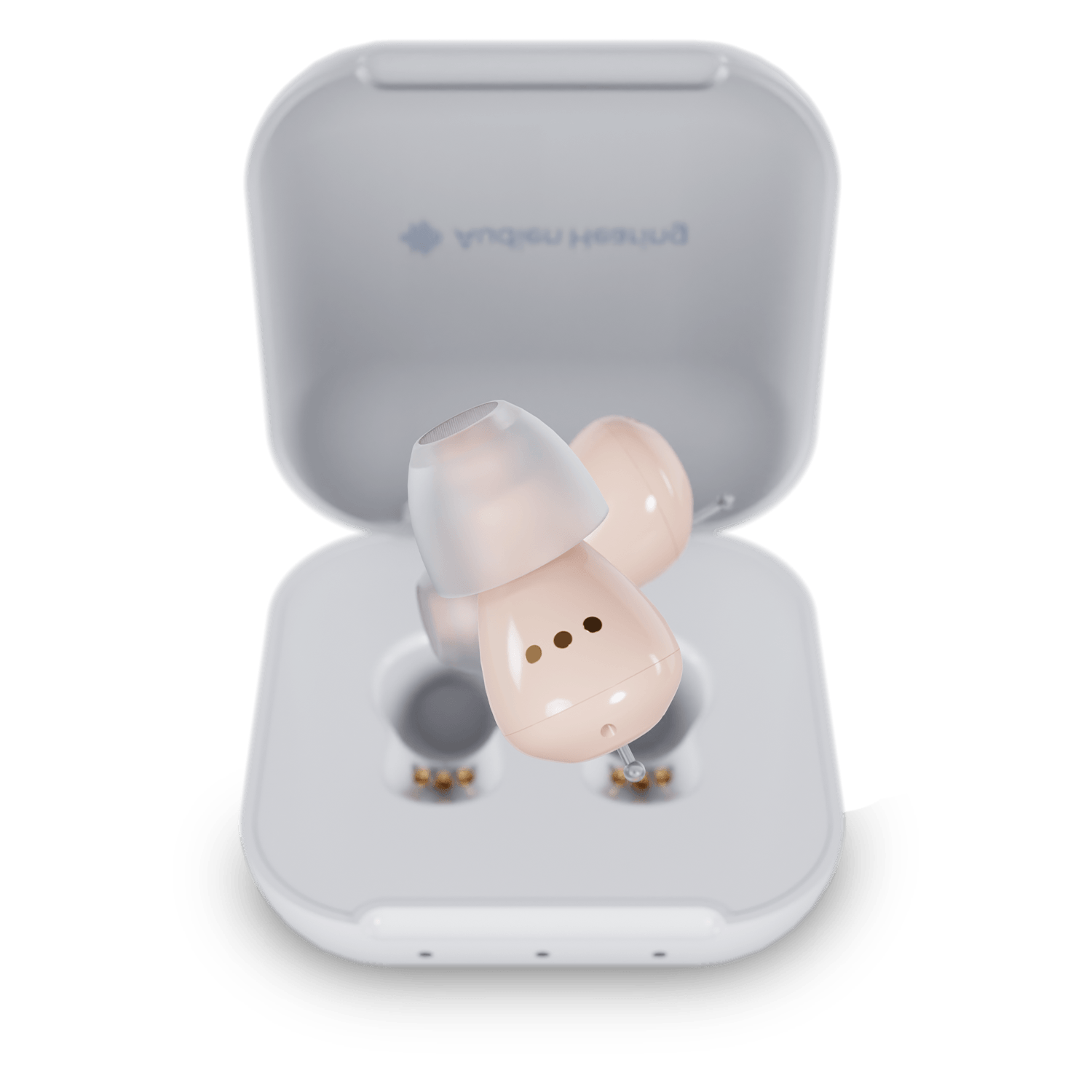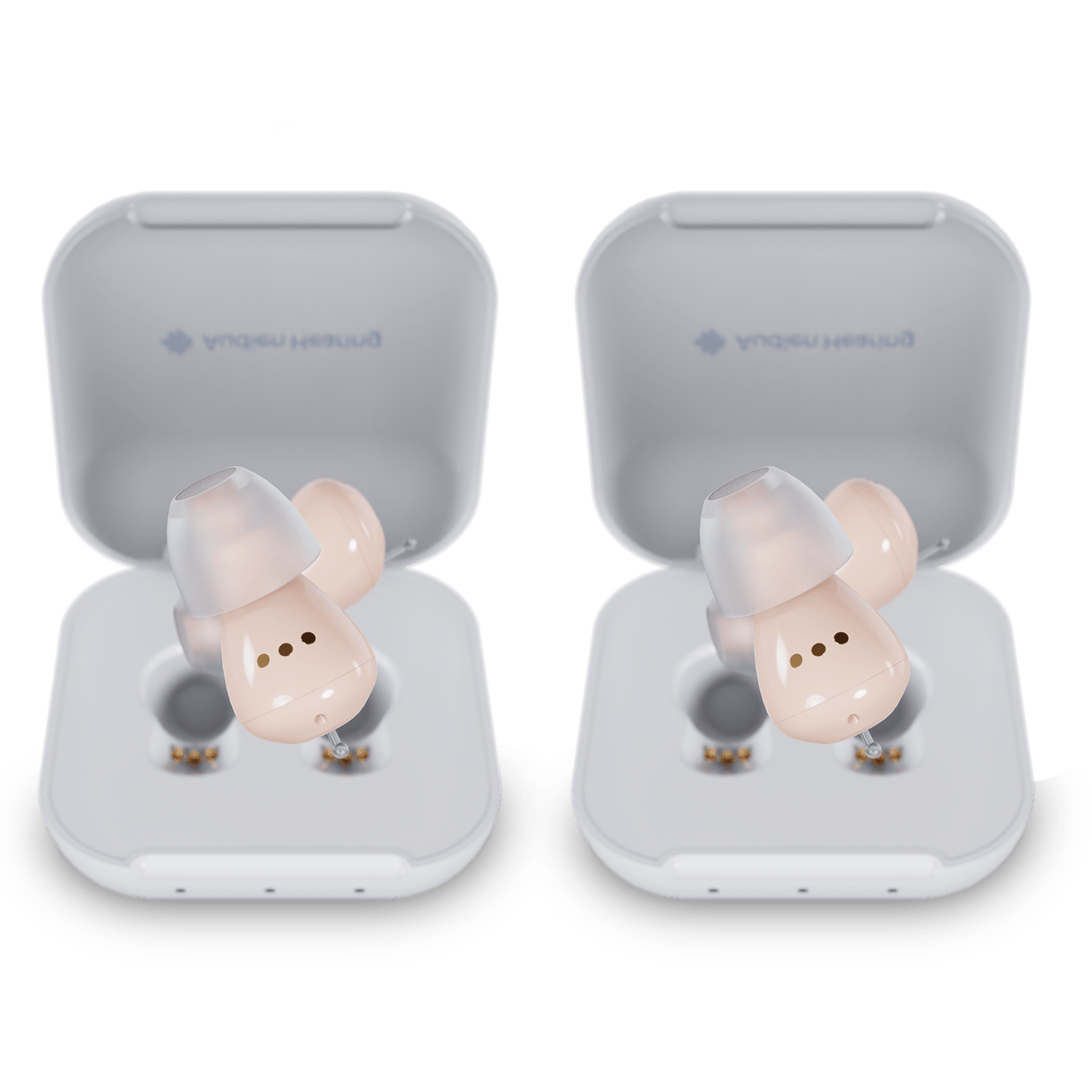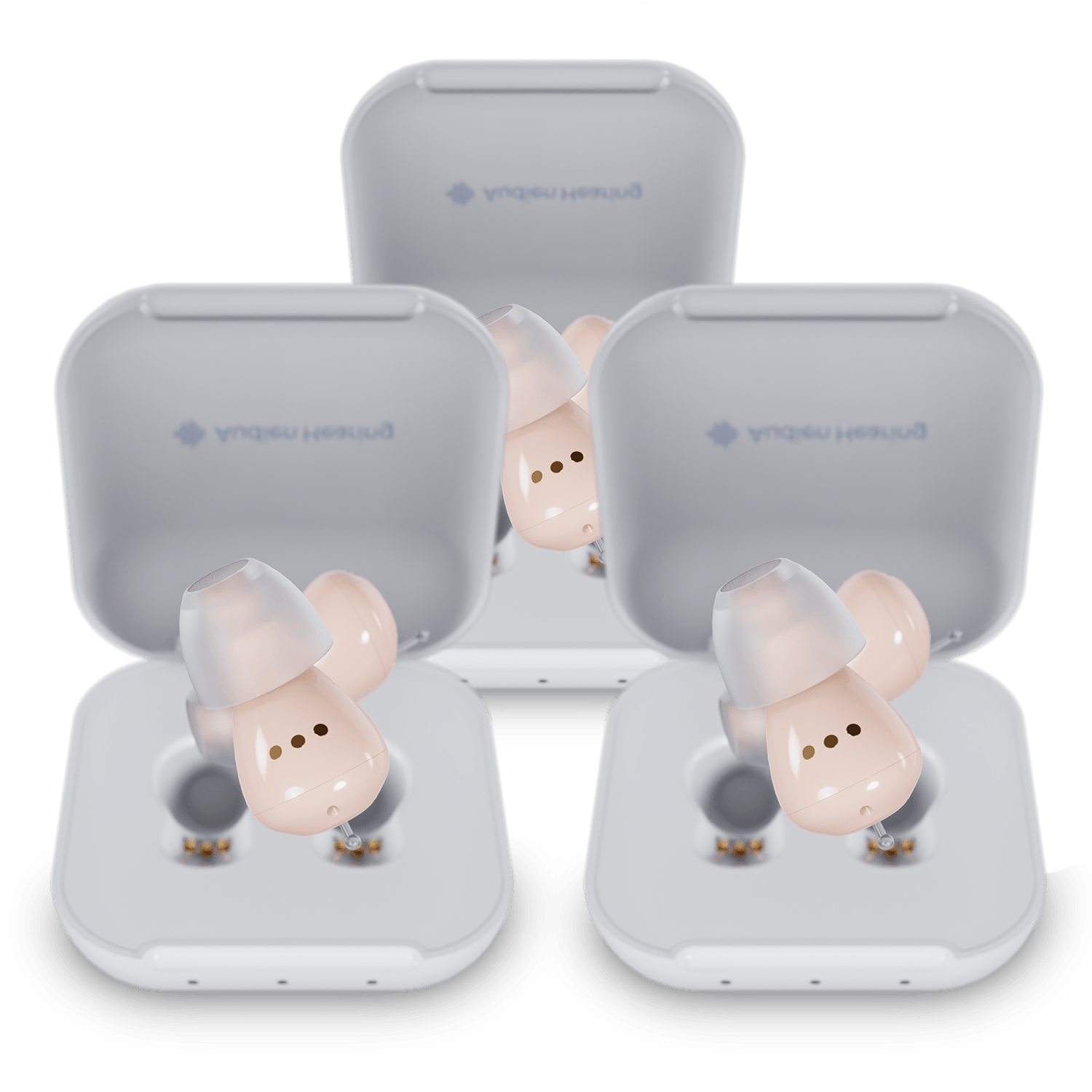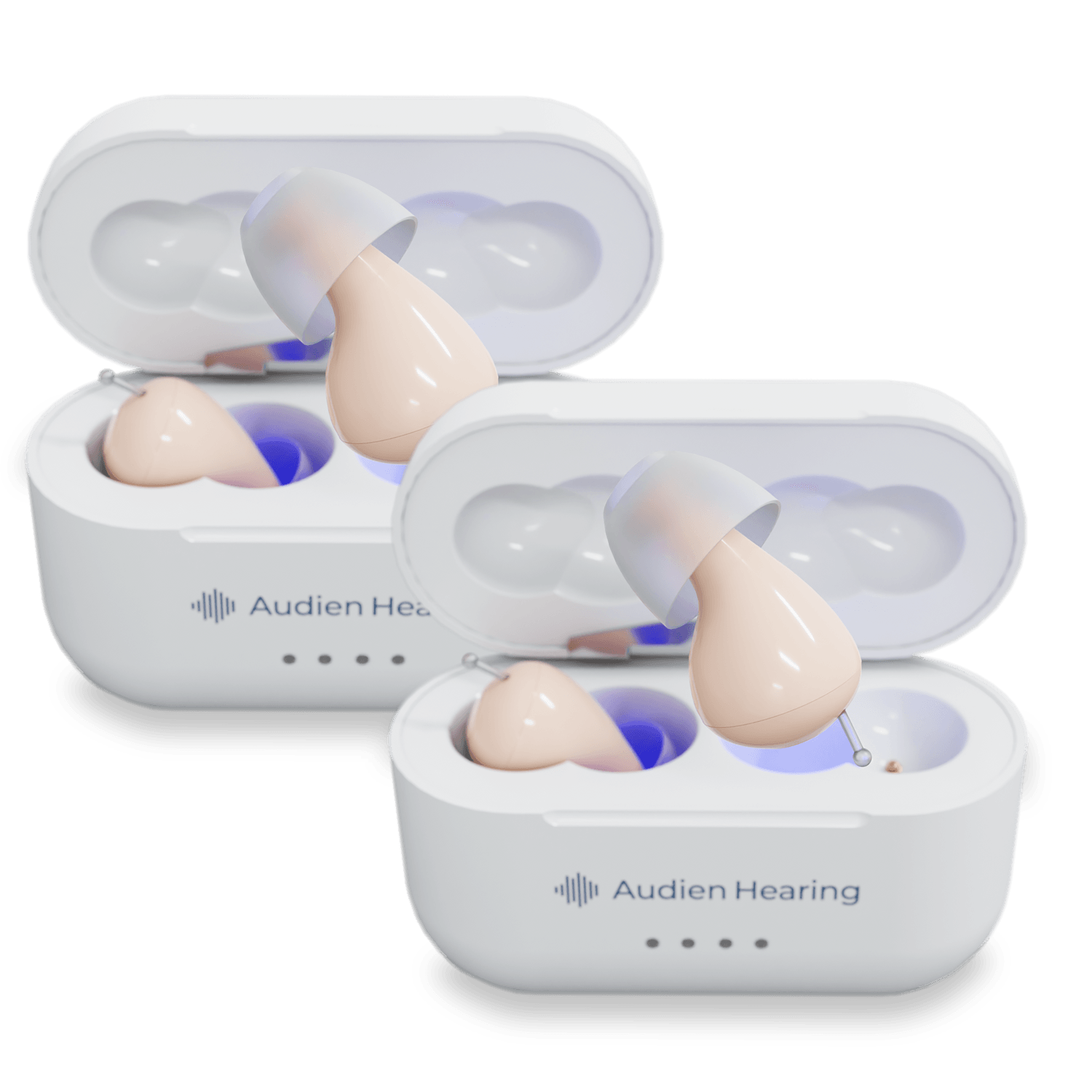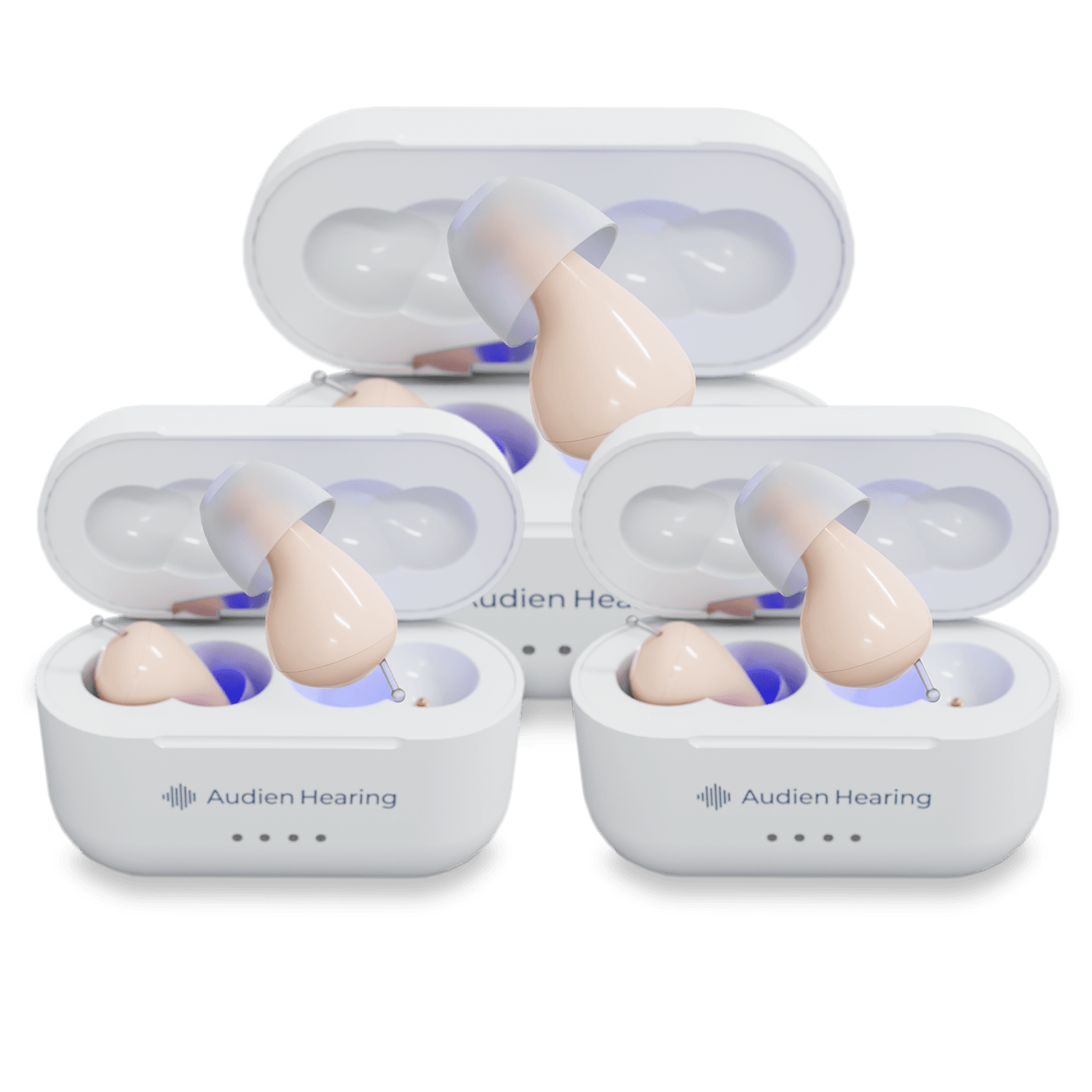Your friends mean well when they share a cousin’s difficult experience with hearing aids, or when they reassure you that you don’t need them yet.
As an audiologist, I hear these same myths repeated week after week. Often, well-meaning friends and family pass along outdated information—or make comments intended to comfort—that can actually keep people from getting the help they need.
Let's set the record straight on what's actually true about modern hearing aids.

Myth #1: "They Make You Look Old"
Your friends might say hearing aids scream "senior citizen." They picture the large beige bananas their grandfather wore in the 1980s, the ones that whistled during quiet moments at church.
Here's what's actually happening with modern hearing aids: they've become nearly invisible. The Atom Pro 2 sits entirely inside your ear canal, smaller than a coffee bean. Unless someone's examining your ear, they won't see it. The Ion series, though it sits behind the ear, sleekly tucks under your hair and comes in colors that blend with skin tone.
But let's talk about what really ages you. It's the constant "What?" The blank stare when you miss a joke. The inappropriate response because you guessed wrong at what someone said. I watched a patient's daughter's face fall when her mother laughed at the wrong moment during a serious story. That misunderstanding, that disconnect, that is more obvious, not wearing a tiny piece of technology that helps you engage fully in conversation.
We wear glasses without shame. We check our phones constantly. We track our steps and heart rate with watches. Hearing aids are just another tool, except these help you connect with people instead of technology.
Myth #2: "They Make Everything Too Loud"

Someone always has a story about hearing aids that made newspaper pages sound like thunder. Usually it's about their father's devices from 20 years ago, or hearing aids that were never properly adjusted.
Here's what your friend doesn't understand: modern hearing aids don't just amplify sound like turning up a stereo. They process it - isolating speech for maximum clarity.
The Ion Pro contains a tiny computer that analyzes incoming sound thousands of times per second. It knows the difference between your grandchild's voice and the dishwasher running. It can tell when you're in a restaurant versus your living room and adjusts accordingly.
Today’s devices offer both hearing profiles and listening modes to give you clearer sound in real life. Hearing profiles are set up at the beginning and shape the overall programming of your device, so it’s tailored to your specific hearing needs.
On top of that, you can switch between listening modes for different environments. For example, Conversation Mode pulls voices out of the chaos like a skilled bartender catching your order in a crowded bar, while TV Mode makes dialogue crisp without letting explosions overwhelm you. Even our simpler models, like the Atom 2, come with four listening modes so you can adapt easily to daily situations.
This isn't your grandfather's "volume knob" approach. It's sophisticated sound processing that makes speech clearer without making your coffee cup sound like a cymbal crash.
Myth #3: "You Don't Need Them Yet"

This might be the most damaging myth. Friends notice you hear "most things" and suggest waiting until you "really" need help.
Here's the problem: hearing loss happens gradually, like gaining weight. You don't notice those few pounds, then ten, until suddenly your clothes don't fit. Your brain works overtime to fill in missing pieces, exhausting you without realizing why - this is called listening fatigue. By the time everyone agrees you need help, you've spent years straining, guessing, and slowly withdrawing from situations where hearing is difficult.
The research is clear and sobering. Johns Hopkins found that untreated hearing loss increases dementia risk. The worse the hearing loss, the higher the risk, up to five times for severe loss. But here's the hope: early treatment with hearing aids can reduce this risk by 32%. That's not a small number. That's the difference between staying sharp for your grandchildren's weddings and missing precious memories.
Your auditory system is like any other part of your body: use it or lose it. The pathways in your brain that process certain sounds can actually weaken from lack of use, like a trail in the woods growing over when no one walks it. The longer you wait, the harder it becomes to clear that path again.
If you're turning up the TV, missing parts of conversation, or finding social situations exhausting, you already need help. There's no prize for struggling longer than necessary.
Myth #4: "Good Ones Cost Thousands"

The neighbor who paid $7,000 for hearing aids. The stories about how expensive devices can be. These experiences are real, but they don’t tell the whole story.
Prescription hearing aids often cost thousands because the price includes more than just the device — it also covers the provider’s time, bundled follow-up care, and services like custom fittings and adjustments. For many people, that level of care and customization is essential, especially with more complex hearing needs.
But if you’re someone with mild to moderate hearing loss, you may not need that full clinic pathway right away. That’s where OTC hearing aids like Audien come in. By selling directly to consumers, we remove the extra layers of cost and make high-quality devices much more affordable. The Atom One starts at $98 per pair, and even our most feature-rich model, the Ion Pro, is $689.
These aren’t “discount” devices — they use the same class of digital chips and rechargeable technology as traditional brands, but at a price point that makes them accessible to many more people. For some, OTC can be a first step; for others, prescription care may eventually be the right option. The key is that you have choices.
Myth #5: "You Can't Adjust to Them"

Everyone knows someone who tried hearing aids and gave up. The devices sit in a drawer somewhere, an expensive reminder of failure. Your friend tells this story with a knowing look, as if it's inevitable.
Here's what usually happened: they expected immediate perfection. Hearing aids aren't like glasses that instantly correct vision. Your brain has spent years adapting to hearing loss, like learning to read in dim light. When sounds suddenly return, it needs time to recalibrate.
The first week, your own voice sounds strange, like hearing a recording of yourself for the first time or an echo. That's normal. It is your voice - but amplified. Background noises seem prominent because your brain hasn't relearned to filter them yet. The air conditioner you never noticed becomes a presence. The clock's tick returns. Everything might have a tinny quality as high frequencies return after a long absence, like tasting sugar after months without it.
Most people adapt within 2-4 weeks if they wear their devices consistently. Not just for "important" things, but all day, every day. Your brain needs steady input to rewire itself properly, like physical therapy after an injury.
This adjustment period is why Audien offers a 45-day trial, longer than the typical adaptation time. You have time to get through the strange phase and into the "how did I live without these?" phase that follows like sunrise after a long night.
Myth #6: "They're High-Maintenance"

Stories about whistling feedback, short battery life, or constant repairs often circulate — but these usually reflect older technology or poorly fitted devices. Modern hearing aids have solved most of these issues. For example, feedback (that high-pitched whistle) is now rare when devices are fitted with the correct dome size, and today’s feedback suppression systems detect and stop it before it becomes noticeable.
Battery anxiety is mostly gone too. The Atom series provides 24-48 hours per charge. The Ion series offers 48 hours. You charge them overnight like your phone, and they're ready for the next day. No more fumbling with tiny batteries that seem designed to roll under furniture at the worst possible moment.
Daily maintenance takes 30 seconds. Wipe them with a dry cloth, brush away any wax, put them in their case. The Atom Pro 2 even sanitizes itself while charging, using UV light to kill bacteria. Less work than maintaining your coffee maker, and far more rewarding.
Myth #7: "Insurance Will Cover Them Eventually"

The most expensive myth of all. Friends advise waiting because surely insurance will help when you "really" need them.
Insurance coverage for hearing aids remains limited. Medicare, for example, still classifies hearing aids as “routine” rather than “necessary,” a policy that has not changed since 1965. Most private insurance plans follow suit, sometimes offering only partial assistance — for instance, $500 toward devices that may cost several thousand dollars.
At the same time, research shows that untreated hearing loss can increase long-term health costs. Falls related to balance issues can result in surgeries costing tens of thousands of dollars. Depression linked to social isolation and cognitive decline requiring memory care can add $10,000 to $90,000 annually in healthcare expenses.
While coverage gaps are frustrating, the good news is that over-the-counter options like Audien provide an affordable and accessible way to address hearing loss early. Starting support sooner — without waiting on insurance — can help people stay engaged, independent, and connected in daily life.
The Reality About Modern Hearing Aids

Let's replace myths with facts. Today's hearing aids are:
Discrete enough that most people won't notice them. Smart enough to adjust to your environment automatically. Beneficial as soon as you notice any hearing difficulty. Affordable without insurance help. Comfortable after a brief adjustment period. Simple to maintain with minimal effort. Available right now, no waiting required.
They won't restore perfect hearing—they're tools, not miracles. But they will help you understand conversation without exhaustion, catch the TV at normal volume, and feel confident in social situations again. They'll return the rustle of leaves, the purr of your cat, the whispered "I love you" from across the pillow.
Moving Past the Myths

Your friends mean well, but they're often sharing stories from another era, like warning you about party lines when you're buying a smartphone. If you're asking people to repeat themselves, avoiding restaurants because they're too challenging, or feeling tired after conversations, you're ready for help now.
Don't let outdated myths keep you from better hearing. With Audien's 45-day trial, you can test reality against fiction in your own life. Experience what modern hearing aids actually do, how comfortable they are, how quickly you adjust.
The biggest myth? That struggling is somehow noble or necessary. That missing your granddaughter's whispered secrets or your spouse's quiet jokes is just part of getting older. Clear hearing isn't vanity or weakness. It's choosing connection over isolation, engagement over exhaustion, the full symphony of life over a muffled existence.
At today's prices, with today's technology, there's no reason to let myths stand between you and better hearing. Your friends' outdated stories shouldn't write the next chapter of your life. You should—and it should be one you can hear clearly.
